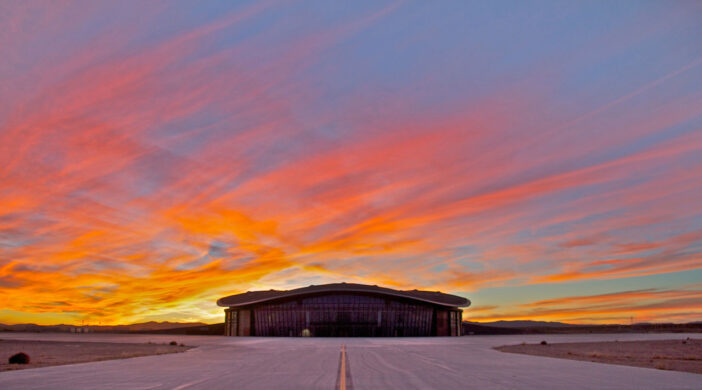With Virgin Galactic (once again) promising that suborbital tourism flights from Spaceport America in New Mexico are right around the corner, the authority that oversees the facility has decided it needs a brand new building there.
The Spaceport Technology and Reception Center’s mission “will be to become the welcoming face to staff, visitors, and prospective customers visiting or working at Spaceport America. The proposed 30,000 square foot STARC building will be a multi-use facility; it will house the Spaceport’s core IT server center, staff offices and conference rooms, an Auditorium, food preparation and dining area, virtual experience center, and 2nd and 3rd floor lounge and viewing areas,” according to a request for proposals (RFP) issued by the New Mexico Spaceport Authority (NMSA).
“The new building will provide modern, comfortable work and meeting spaces for NMSA staff and a means to receive, entertain and educate groups of visitors and/or potential customers,” the document added.
The phase 1 RFP is for an architect-engineer firm to design the building. It was released on Feb. 9, with responses due on March 16.
NMSA currently operates from an office building in Las Cruces that is about an hour’s drive from the spaceport.
Virgin Galactic has said it plans to complete flight tests of its VSS Unity rocket plane at Spaceport America by the end of March. One additional test with four company employees in the passenger cabin is scheduled before the program is complete.
Three Italian Air Force officers — Walter Villadei, Angelo Landolfi, and Pantaleone Carlucci — are scheduled to fly on the company’s first paid flight in the second quarter of this year. Virgin Galactic is then scheduled to begin flying the first of 900 ticket holders, some of whom put down deposits back in 2005.
Virgin Galactic has a long history of delays, so it’s possible that this schedule could slide to the right. Company officials are expected to provide a schedule update during its quarterly and full-year earnings call on Feb. 28.
The news that NMSA is going to spend money on a new building is not going to be welcome news to critics of the spaceport. They say the facility has not generated the economic benefits promised when Virgin Galactic Founder Richard Branson and then-Gov. Bill Richardson announced it in December 2005.
Virgin Galactic is running 13-14 years behind schedule in starting commercial service. In December 2005, New Mexico agreed to spend $200 million to construct a custom-built spaceport where Branson’s space company would be the anchor tenant. According to the press release:
A design for SpaceShipTwo is now in its final planning stages and construction of the commercial prototype is expected to commence in 2006 and be flying by 2008. It is expected that five SpaceShipTwo’s and two White Knight Two carrier aircrafts will be built, in order to allow 50,000 customers to experience personal spaceflight over a ten year period up to 2019.
Officials also promised:
- $1 billion in total spending, payroll of $300 million and 2,300 jobs by the fifth year of operation, and,
- $750 million in total revenues and more than 3,500 jobs by 2020.
Virgin Galactic has yet to fly a single paying customer. The economic benefits and new jobs generated have been a fraction of what was promised 17 years ago.
Although Virgin Galactic and other tenants pay rent, the spaceport is continuing to cost New Mexico millions of dollars annually because it is not generating enough revenue to cover its budget. Since Virgin Galactic’s facilities were completed, New Mexico has spent tens of millions of dollars to upgrade the spaceport’s infrastructure in order to attract other tenants.
Residents of Dona Ana and Sierra counties continue to pay a quarter of a cent use tax in order to pay off bonds sold to fund construction. Residents voted to tax themselves in return for the economic boost the facility would provide.
The city of Truth or Consequences was one of the nearby communities hoping to benefit from the spaceport. Today, T or C is struggling to provide one of the basic services that residents require. Searchlight New Mexico reports:
In 2022, over 200 million gallons — a staggering 43 percent of the water in the system — was lost to leakage, according to T or C’s city manager, Bruce Swingle. Three years earlier, losses were at 28 percent. Not only does this show how quickly the system has been deteriorating, but “it’s a sign of things to come,” Swingle said during an interview at his office.
Line breaks in the fragile system are a near-daily event, with over 400 repairs made last year. As soon as one section is fixed, Swingle said, “the water finds the next most vulnerable spot” and bursts through it, like an endless game of water-line Whac-a-Mole. “We’ve had cars drive into sinkholes” after subsurface seepages destabilized the ground, he added….
Two areas of town — the east side and the so-called metal streets, with names like Nickel and Tin — are in “critical condition,” Swingle said. “We have to replace those lines as soon as possible. It’s literally a crisis, and it’s only going to get worse in the next few months.” If nothing is done, the city faces system-wide failure.
Replacing those lines will cost an estimated $20 million, engineers have concluded. Performing all of the improvements that the system needs has a price tag closer to $150 million. T or C cannot afford either option. And it is not alone.
There are problems with repairing water and waste water systems across the state. In 2021, New Mexico Legislative Finance Committee estimated that repairing the state’s water and waste water infrastructure would cost in excess of $2.8 billion.

